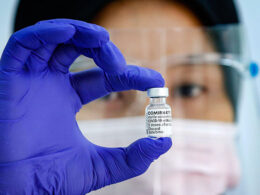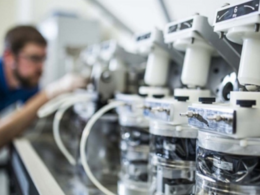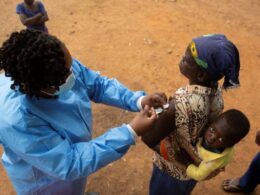Between a Rock and Hard Place, March 2022
Recommendations for Balancing Patient Safety and Pandemic Response
APIC Association for Professionals in Infection Control and Epidemiology, Inc.
March 17, 2022
The Association for Professionals in Infection Control and Epidemiology has published an expansive report on how the United States can be better prepared for the next pandemic.
Federal, state, and local policy makers have a lot of work to do to prepare the country for the next pandemic, the Association for Professionals in Infection Control and Epidemiology (APIC) says in a new report.
The United States was inadequately prepared to respond to the coronavirus pandemic such as insufficient supplies of personal protective equipment (PPE). The country leads the world in COVID-19 deaths, with 991,260 lives lost as of today, according to worldometer.
More than a dozen infection preventionists contributed content to the new report, which APIC 2022 President Linda Dickey, RN, MPH, said requires urgent attention. “APIC is issuing this call-to-action as we all recall the nightmare of extensive supply shortages and overworked healthcare workers. Especially troubling to APIC is how many preventable infections were transmitted inside hospitals during COVID because resilience was not built into our healthcare system,” she said in a prepared statement.
Sizable investments will be necessary to prepare the country to respond effectively to the next pandemic, she said. “For the U.S. to create a safer, more resilient healthcare system, policymakers should make the substantial investments recommended by the hands-on infection prevention experts who had a unique vantage point as the pandemic overwhelmed hospitals, nursing homes and clinics nationwide.”
The report makes 10 recommendations to improve pandemic preparedness in the United States.
- Improve PPE
- Congress should fund research at the National Institute for Occupational Safety and Health to develop a one-size-fits-all respiratory device that can be used in healthcare facilities during infectious disease emergencies.
- Congress should fund research to replace some disposable PPE with PPE that is cleanable and reusable.
2. Promote the use of masks in response to infectious disease threats
- Federal, state, and local officials should recommend that the general public use masks to combat respiratory viruses.
- Congress should fund research to develop standards for masks for the general public and to determine the best types of masks for different types of infectious diseases.
- Federal agencies should share mask research findings with the public to generate trust in mask use to prevent the spread of respiratory viruses.
3. Improve supply chain for PPE and disinfection supplies
- Federal officials should develop better processes to manage, track, and rapidly distribute PPE during a public health emergency. This effort should include greater diversity in production locations.
- Federal and state officials should anticipate high demand for essential supplies and be able to meet operational healthcare demand.
- Federal officials should anticipate general-public demand for supplies such as cleaning materials to make sure essential supplies are available for healthcare workers and facilities.
- Government officials should research when PPE can be decontaminated for reuse by healthcare workers.
4. Infection preventionists should play prominent roles during a pandemic
- Federal officials should require that infection preventionists play a role in determining policies and protocols related to disease transmission at healthcare facilities such as patient placement, workflow reviews, and patient isolation.
- Federal officials should require that infection preventionists serve on teams that develop crisis standard of care protocols for PPE, anti-infective therapy, and vaccinations at healthcare facilities.
- Federal officials should require that an infection preventionist participate in developing an infectious disease surveillance program for healthcare facilities.
- Federal officials should require that an infection preventionist should oversee the analysis and reporting of pandemic surveillance program data for a healthcare facility.
- The Centers for Medicare & Medicaid Services (CMS) should require nursing homes to have at least one infection preventionist.
- CMS should require additional nursing home staff to be trained in infection prevention and control (IPC) to establish surge capacity during an infectious disease outbreak.
- CMS should require routine mandatory surveillance for healthcare-associated infections in nursing homes.
5. Properly trained healthcare workers should staff high-risk settings
- Congress should provide support to healthcare facilities to ensure they have enough infection preventionists during a pandemic.
- Congress should provide support to healthcare facilities to make sure IPC and employee occupational health teams can do contact tracing, conduct employee exposure testing, and implement employee vaccination programs.
- Congress should provide funding to address healthcare surges during a pandemic and avoid suspension of nonurgent medical procedures, which can lead to worse outcomes for individual patients and long-term public health problems.
6. Promote infection prevention and control surge capacity
- Congress should make sure that healthcare facilities, public health agencies, primary care providers, and the public have access to testing.
- Congress should fund contact tracing administered by public health agencies and healthcare facilities to limit the spread of disease during a pandemic.
7. Testing and contact tracing
- Congress should direct federal agencies to make efforts in public health education about the benefits and effectiveness of vaccines in preventing infectious diseases.
- Congress should fund research and share strategies to address vaccine misinformation.
- Policy makers should fund healthcare facility IPC and employee occupational health departments to tackle vaccine hesitancy among healthcare workers.
8. Data sharing and interoperability for infection surveillance data
- Congress should provide funding for healthcare facilities to have enough IPC capability to support patient safety during a pandemic and have enough infection preventionists during a pandemic.
- Congress should fund “just-in-time” IPC education and training for healthcare workers and the broader workforce during a pandemic.
- Congress should support academic pathways at universities for infection preventionists.
- Congress should fund incentives such as loan repayment programs to encourage the next generation of healthcare professionals to become infection preventionists.
10. Pandemic preparedness workforce capacity and training
- Congress should provide funding for healthcare facilities to have enough IPC capability to support patient safety during a pandemic and have enough infection preventionists during a pandemic.
- Congress should fund “just-in-time” IPC education and training for healthcare workers and the broader workforce during a pandemic.
- Congress should support academic pathways at universities for infection preventionists.
- Congress should fund incentives such as loan repayment programs to encourage the next generation of healthcare professionals to become infection preventionists.
Christopher Cheney is the senior clinical care editor at HealthLeaders.
Originally published at https://www.healthleadersmedia.com.
Names mentioned
President Linda Dickey, RN, MPH












